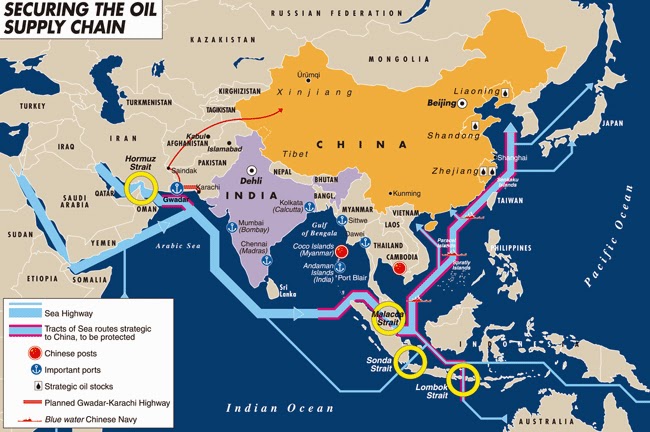India should take the initiative to constitute Indian Ocean Community, a United States of Indian Ocean to promote development and peace.
Kalyanaraman
The four straits of Hormuz, Malacca, Sonda and Lombok are indicated above by yellow rings, gateways to the Indian Ocean from the East.
Published: February 5, 2014 21:48 IST | Updated: February 5, 2014 21:50 IST
New Indian Ocean exercise shows reach of China's Navy
This also marked the first deployment of the Changbaishan, China's largest landing ship which is equipped with advanced weapons systems, in a drill of this kind.
The Chinese Navy has conducted rare exercises in the Lombok Strait in the Indian Ocean near Indonesia, with the drills seen by analysts as underlining China's expanding capabilities in carrying out operations in waters far beyond its borders.
A three-ship flotilla of the South Sea fleet, which included the large amphibious aircraft Changbaishan and two destroyers, conducted 10 exercises, including anti-piracy, search and rescue, and damage control drills, over a five-day exercise starting January 29, based out of the Lombok Strait, a narrow strip of water that runs from the Java Sea, near Indonesia, and is north of Australia.
On Monday, the ships left the Indian Ocean for drills in the West Pacific Ocean, the official Xinhua news agency reported. The Lombok drills also included simulations for warfare to test the response of command systems and soldiers'“combat skills”. The drills aren't China's first in the Indian Ocean: the People's Liberation Army Navy (PLAN) has carried out 16 drills, but mostly in the western Indian Ocean near the Gulf of Aden. As with the Gulf of Aden exercises, the drills focused on anti-piracy and search and rescue measures.
However, last week's drills were seen by analysts as being significant by breaking new ground in several ways. This was the first drill of this nature in the Lombok Strait, and also marked the first time the PLAN had, in its drills, charted a new route from the South China Sea to the Indian Ocean. In earlier drills, ships sailed up the much-traversed Malacca Straits, a significant waterway for global trade that opens out near the Andaman Sea, and is a crucial link between the Indian Ocean and East Asia. This also marked the first deployment of the Changbaishan, China's largest landing ship which is equipped with advanced weapons systems, in a drill of this kind.
Srikanth Kondapalli, an expert on the Chinese military at Jawaharlal Nehru University, said the drill may have been a signal from China about the dispute over the South China Sea, whose waters and islands are contested by a number of countries. “The drill took place in Lombok, which is beyond the nine-dotted line [that reflects China's claims]. This is something new,” he said, and suggested that the PLAN may be demonstrating its capabilities to access the disputed region from another direction “from behind”.
A second signal was tied to the Malacca Straits, which are a key route for China's energy imports. The dependence on the narrow strait led former leader Hu Jintao to warn of China's “Malacca dilemma”, triggering fresh initiatives by Beijing to establish alternate routes for imports, such as through ports in Myanmar and on-going projects in Bangladesh and Pakistan. “A third message,” Professor Kondapalli added, “is that they can come closer to the Andaman & Nicobar joint command through Lombok, and not just through Malacca”.
He said the drill could be seen as “a preliminary attempt” by the PLAN to see how they can fare in operations far away from China's borders in the Indian Ocean, where they lack bases for logistics and support. China has recently pushed commercial ties with several littoral states, and is also involved in port projects in a number of countries neighbouring India.
Last year, a Chinese think-tank released a first “blue book” or policy advisory on the Indian Ocean, stressing that Beijing should be driven by commercial, rather than military, objectives, considering the importance of the Indian Ocean Region to its energy security. At the same time, it called for “a clear development strategy in the Indian Ocean Region” which would “not only [be] a sign of China's self-confidence [but] also a clear demonstration of China's strategic interests.”

